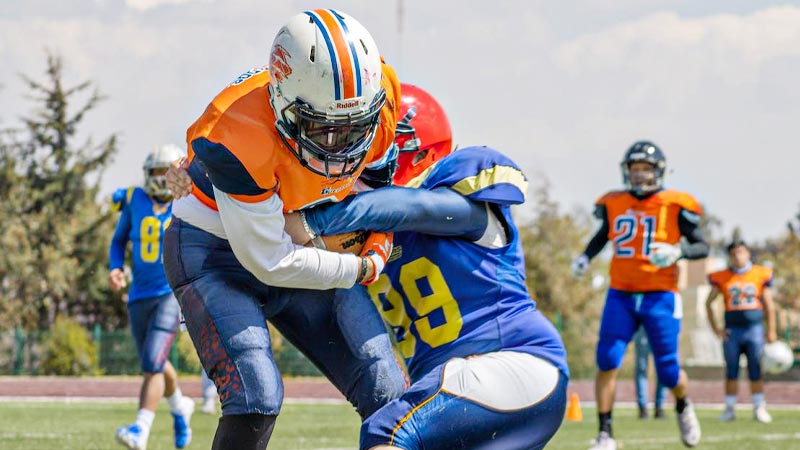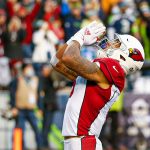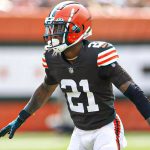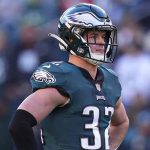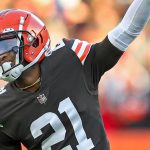American football is a sport defined by intricate rules and strategic maneuvers, and one of its fundamental concepts that often spark discussions is “down by contact.”
This rule plays a pivotal role in determining ball possession, advancing the game, and shaping the strategies of both offensive and defensive teams. In this blog post, we delve into the nuances of the “down by contact” rule in American football.
From its definition and implementation to its controversies and impact, we aim to provide a comprehensive understanding of this essential aspect of the game. So, stay focused.
What Is Football Down By Contact?
Football “down by contact” is a fundamental concept in American football that dictates the advancement of the ball and the player’s possession during a play.
When a ball carrier is tackled or touched by a defensive player while any part of their body other than their hands or feet is touching the ground, they are considered “down by contact.” This means the play is officially over at that point, and the ball’s location is marked where the player was touched or tackled.
Unlike plays where the ball carrier is not down by contact and the ball becomes dead when it hits the ground, the down-by-contact rule ensures that the offensive team retains possession and the play continues.
This principle prevents fumbles caused by a ball carrier losing possession due to contact with the ground while being tackled. It’s a crucial aspect of determining the progress of the play and is central to the strategy and flow of American football games.
What Causes Down By Contact?
“Down by contact” occurs when a ball carrier in American football is tackled or touched by a defensive player while any part of their body other than their hands or feet is touching the ground. The key factors that cause a player to be considered “down by contact” include:
Tackling
If a defensive player successfully tackles the ball carrier and any part of the ball carrier’s body (other than hands or feet) makes contact with the ground, the play is considered over, and the ball’s location is marked at that spot.
Touches
Even if a ball carrier is not fully tackled but is touched by a defensive player while any part of their body (other than hands or feet) is touching the ground, the play is also considered over. This touch signifies the end of the ball carrier’s ability to advance.
Contact with the Ground
If a ball carrier falls to the ground, whether due to stumbling, tripping, or any other reason, and they are touched by a defensive player while down, the play is deemed over. This rule prevents fumbles caused by the ball carrier losing possession when contacting the ground.
In all these cases, the intent is to determine when the ball carrier’s forward progress has been halted and to prevent fumbles or turnovers resulting from incidental contact with the ground while being tackled or touched.
The Aftermath of Football Down By Contact
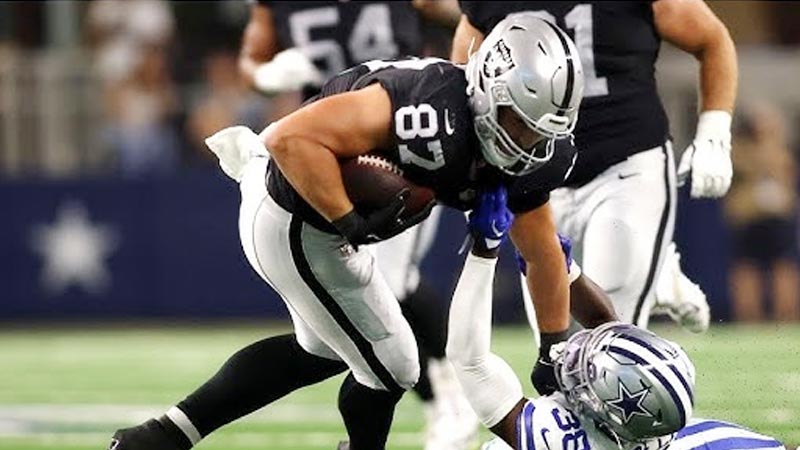
The aftermath of a “down by contact” situation in American football has several immediate implications for the ongoing play and the overall flow of the game:
Play Stoppage
When a ball carrier is deemed “down by contact,” the play is immediately halted. The referee blows the whistle to signal the end of the play, and the ball’s position is marked at the spot where the ball carrier was touched or tackled. This stoppage allows both teams to reset for the next play.
Yardage
The yardage gained by the ball carrier up to the point of contact is recorded as the team’s progress on that play. This yardage is added to or subtracted from the team’s previous position on the field, depending on whether the play was on offense or defense.
Possession Retention
The team on offense retains possession of the ball if the ball carrier is “down by contact.” Unlike situations where a fumble occurs, in which possession might change hands, the “down by contact” rule ensures that the offense continues its possession without any turnovers resulting from contact with the ground.
Down and Distance
The down and distance markers are updated based on the yardage gained or lost up to the point of contact. This affects the strategy and decisions the offensive team makes for the upcoming plays.
Game Clock Management
The game clock is stopped when a player is deemed “down by contact.” This stoppage allows the game clock to be properly managed and ensures that both teams have an equal opportunity to execute their plays within the designated time limits.
Substitutions
The play stoppage provides an opportunity for both teams to make substitutions, adjust their defensive or offensive formations, and plan their next moves.
The aftermath of a “down by contact” situation involves stopping the play, determining the yardage gained or lost, retaining possession for the offensive team, updating down and distance markers, managing the game clock, and allowing for adjustments by both teams.
Football Down By Contact in NFL and NCAA
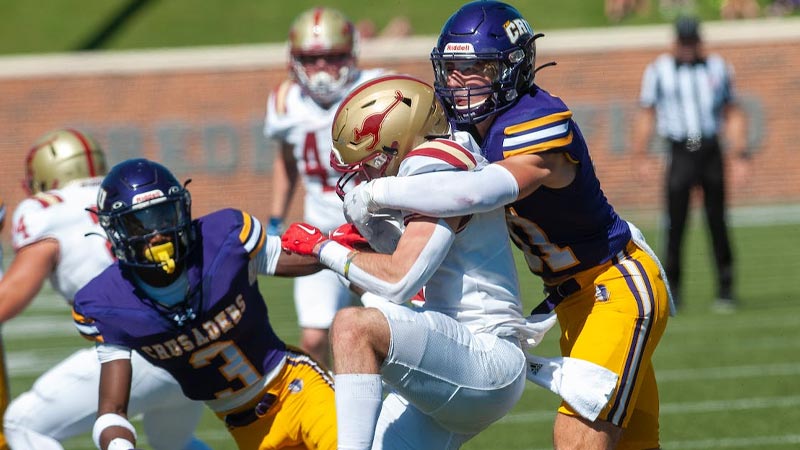
The “down by contact” rule is applied similarly in both the National Football League (NFL) and the National Collegiate Athletic Association (NCAA) football, with slight differences due to the specific rule variations of each league. Here’s how it works in both contexts:
NFL (National Football League)
In the NFL, a player is considered “down by contact” when any part of their body other than their hands or feet touches the ground after being tackled or touched by a defensive player.
This rule applies to both ball carriers and receivers attempting to make a catch. Once the player is down by contact, the play is blown dead, and the ball’s position is marked where the contact occurred. The team in possession retains the ball, and the down and distance markers are adjusted accordingly.
The game clock stops temporarily, and play resumes after these adjustments. Coaches have the opportunity to challenge the ruling on the field if they believe a player was not down by contact.
NCAA (National Collegiate Athletic Association)
The “down by contact” rule in NCAA football closely mirrors that of the NFL. A player is considered down when any part of their body, other than their hands or feet, touches the ground after being tackled or touched by a defensive player.
The play is then ruled dead, and the ball’s position is marked where the player was contacted. The offensive team retains possession, and the down and distance markers are updated accordingly.
Similar to the NFL, coaches can challenge the ruling if they disagree with the decision on the field. However, the NCAA has some differences in its targeting and review rules that can impact certain aspects of the game.
Controversies of Football Down By Contact
While the “down by contact” rule is an integral part of American football, it has generated its share of controversies over the years. Some of the main controversies include:
Subjective Interpretation
The determination of when a player is “down by contact” can be subjective and open to interpretation by referees. Different officials might have varying viewpoints on whether a player’s forward progress was halted before they lost possession of the ball, leading to disputes and disagreements.
Fumble Recovery
In situations where a player is ruled “down by contact,” there can be debates about whether the ball was fumbled before or after the player was considered down.
This can affect possession and potentially lead to challenges from opposing teams, as fumble recoveries can have a significant impact on the outcome of a game.
Inconsistent Whistle Timing
Sometimes, referees blow the whistle to signal a play dead too quickly, assuming a player is down by contact. This premature whistle can prevent defensive players from attempting to recover a fumble or continue playing until they hear the whistle, leading to potential missed opportunities for turnovers.
Challenges and Reversals
Coaches have the ability to challenge “down by contact” calls, but challenges are limited, and not all situations are reviewable. Controversy can arise if coaches are unable to challenge a call they believe was incorrect, or if a ruling is upheld or overturned based on limited available camera angles.
Impact on Game Flow
The “down by contact” rule can disrupt the natural flow of the game, as it necessitates play stoppages for ball placement and adjustments to the down and distance markers. This can lead to breaks in momentum and impact the overall pace of the game.
Player Safety
There have been instances where players have been incorrectly ruled “down by contact,” leading to continued contact that might result in unnecessary roughness or even injuries. Ensuring player safety while accurately enforcing the rule can be a challenge.
Technology Limitations
The availability of video replay for challenges is not always perfect, and certain camera angles might not definitively prove whether a player was down by contact. This can result in decisions that are not entirely satisfactory to fans, players, and coaches.
Despite these controversies, the “down by contact” rule remains a fundamental part of the sport, and efforts are continually made to improve officiating accuracy and minimize disputes.
FAQs
What does “down by contact” mean in football?
“Down by contact” is a term used in American football to indicate that a player carrying the ball or attempting to make a reception has been tackled or touched by a defensive player while any part of their body other than their hands or feet is touching the ground.
This rule signifies the end of the play, and the ball’s position is marked where the contact occurred.
Why is the “down by contact” rule important?
The “down by contact” rule is crucial for determining the progression of the game and ensuring fair play. It prevents fumbles caused by incidental contact with the ground during a tackle, allowing the offense to retain possession.
This rule also influences strategies, clock management, and play calling, making it an integral part of the sport’s dynamics.
How is the rule applied in the NFL and NCAA?
Both the NFL and NCAA apply the “down by contact” rule similarly. If a player’s body (excluding hands and feet) touches the ground due to being tackled or touched by a defender, the play is considered dead, and the ball is spotted at the point of contact.
Possession remains with the offensive team, and down and distance markers are adjusted accordingly.
What controversies surround the “down by contact” rule?
Controversies associated with the rule include subjective interpretations by referees, debates over fumble recoveries and premature whistles, challenges and replay reviews, impact on game flow and player safety, and technology limitations in assessing close calls.
How does the “down by contact” rule impact the game?
The rule affects game momentum, play stoppages, and clock management. It shapes offensive and defensive strategies, as teams must adapt to the precise ball placement and adjust down and distance markers following a “down by contact” ruling.
Wrapping Up
The intricacies of the “down by contact” rule provide insight into the dynamics of American football and the meticulous balance between fairness and strategic advantage.
From its inception to its application in the NFL and NCAA, and from controversies to its influence on gameplay, the rule remains an essential component that shapes the outcome of matches and keeps fans engaged in the sport’s ever-evolving narrative. Thank you so much.

